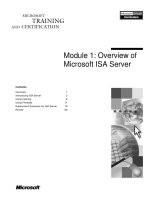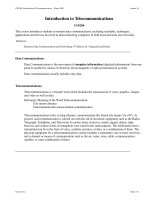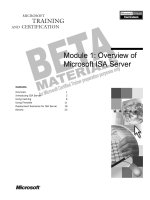Lecture 1: Overview of Java ppt
Bạn đang xem bản rút gọn của tài liệu. Xem và tải ngay bản đầy đủ của tài liệu tại đây (156.22 KB, 14 trang )
1
Lecture 1: Overview of Java
2
What is java?
Developed by Sun Microsystems (James Gosling)
A general-purpose object-oriented language
Based on C/C++
Designed for easy Web/Internet applications
Widespread acceptance
3
Java Features (1)
Simple
fixes some clumsy features of C++
no pointers
automatic garbage collection
rich pre-defined class library
Object oriented
focus on the data (objects) and methods manipulating
the data
all functions are associated with objects
almost all data types are objects (files, strings,
etc.)
potentially better code organization and reuse
4
Interpreted
java compiler generate byte-codes, not native machine
code
the compiled byte-codes are platform-independent
java byte codes are translated on the fly to machine
readable instructions in runtime (Java Virtual Machine)
Portable
same application runs on all platforms
the sizes of the primitive data types are always the same
the libraries define portable interfaces
Java Features (2)
5
Java Features (3)
Reliable
extensive compile-time and runtime error checking
no pointers but real arrays. Memory corruptions or
unauthorized memory accesses are impossible
automatic garbage collection tracks objects usage over
time
Secure
usage in networked environments requires more security
memory allocation model is a major defense
access restrictions are forced (private, public)
6
Java Features (4)
Multithreaded
multiple concurrent threads of executions can run
simultaneously
utilizes a sophisticated set of synchronization
primitives (based on monitors and condition variables
paradigm) to achieve this
Dynamic
java is designed to adapt to evolving environment
libraries can freely add new methods and instance
variables without any effect on their clients
interfaces promote flexibility and reusability in code
by specifying a set of methods an object can perform,
but leaves open how these methods should be
implemented
can check the class type in runtime
7
Java Disadvantages
Slower than compiled language such as C
an experiment in 1999 showed that Java was 3 or
4 times slower than C or C++
title of the article: “Comparing Java vs. C/C++
Efficiency Issues to Interpersonal Issues” (Lutz
Prechelt)
adequate for all but the most time-intensive
programs
8
Install Java
TM
2 Platform on your machine
Can be installed on different platforms:
Unix/Linux
Windows
Mac OS
Follow the on-line instructions:
9
Getting Started: (1)
(1) Create the source file:
open a text editor, type in the code which
defines a class (HelloWorldApp) and then save
it in a file (HelloWorldApp.java)
file and class name are case sensitive and must
be matched exactly (except the .java part)
Example Code: HelloWorldApp.java
/**
* The HelloWorldApp class implements an application
* that displays "Hello World!" to the standard output
*/
public class HelloWorldApp {
public static void main(String[] args) {
// Display "Hello World!"
System.out.println("Hello World!");
}
}
Java is CASE SENSITIVE!
10
Getting Started: (2)
(2) Compile the program:
compile HelloWorldApp.java by using the
following command:
javac HelloWorldApp.java
it generates a file named HelloWorldApp.class
‘javac’ is not recognized as an internal or
external command, operable program or hatch file.
javac: Command not found
if you see one of these errors, you have two choices:
1) specify the full path in which the javac program locates every time.
For example:
C:\j2sdk1.4.2_09\bin\javac HelloWorldApp.java
2) set the PATH environment variable
11
Getting Started: (3)
(3) Run the program:
run the code through:
java HelloWorldApp
Note that the command is java, not javac, and you
refer to
HelloWorldApp, not HelloWorldApp.java or
HelloWorldApp.class
Exception in thread "main" java.lang.NoClassDefFoundError:
HelloWorldApp
if you see this error, you may need to set the environment variable
CLASSPATH.
12
Language basics (1)
Data types
8 primitive types:
boolean, byte, short, int, long, float, double, char
Class types, either provided by Java, or made
by programmers
String, Integer, Array, Frame, Object, Person, Animal, …
Array types
Variables
dataType identifier [ = Expression]:
Example variable declarations and
initializations:
int x; x=5;
boolean b = true;
Frame win = new Frame();
String x = “how are you?”;
int[] intArray;
intArray = new int[2];
intArray[0] = 12;
intArray[1] = 6;
Person pArray = new Person[10];
13
Language basics (2)
Flow of control
if, if-else, if-else if
switch
for, while, do-while
break
continue
14
Supplemental reading
Getting Started
/>
Nuts and bolts of the Java Language
/>
Compiling and Running a Simple Program
/>Java1/compile.html









